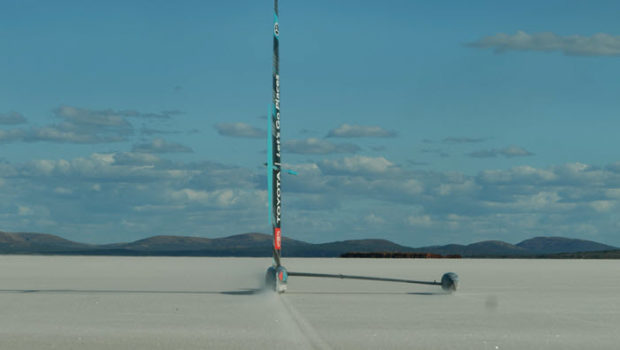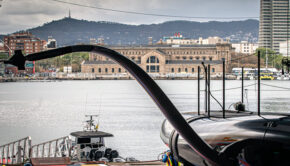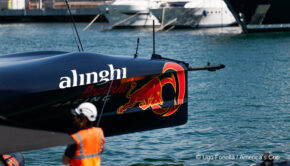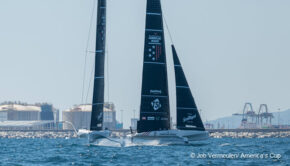America’s Cup: Watching water dry
Published on November 29th, 2022
There is irony in how the America’s Cup defender, eager to deliver high performance racing for the 37th Match, has us watching grass grow. Okay, it’s not watching grass grow, its watching water dry … pretty much the same thing.
Their pet project, which meant to fill a gap in the schedule, now dives into a meteorological education which needs to soon end. Here’s their latest update:
Lake Gairdner in South Australia is vast, a 160km long and 50 km wide salt lake where Emirates Team New Zealand is aiming to break the Wind powered Land Speed World Record in their land yacht called ‘Horonuku’.
The fly in the ointment in the attempt continues to be that the lake and the state of South Australia, and in fact a large amount of Australia has had excessive rain this year, resulting in an uphill battle against the elements for a prolonged stretch of dry salt to let Horonuku fly.
Mount Ive is near the part of the lake where Glenn Ashby and the team have based themselves and daily rainfall is measured.
In November 2021 and January 2022, there were two extreme events where Mt Ive had 10 times and twice their monthly average rain. The January rain fell in three days with most on just one day.
Those two months put excess water in the lake and that water is pushed around by the prevailing wind – several days of pre-frontal N winds pushes the water to the southern end of the lake and the race area while post frontal SW-S winds pushes the water back to the north. Evaporation would normally reduce the amount of mobile water in the lake, but this year, the evaporation has been matched by further rain.
January 2022 was a monthly all-time record, as was November 2021 and August 2022 was close to a monthly record. In summary – the conditions now are a result of the extremely wet last summer and the re-occurring rain throughout this year – never allowing the lake to dry out by evaporation.
So what is next?
The rain over the western half of Australia (including South Australia) is primarily driven by the Indian Ocean measured with the Indian Ocean Dipole (IOD) which is an irregular oscillation of sea surface temperatures and related atmospheric circulations.
This has been in a negative phase which tend to favor above average rainfall. That index has changed over the last month to neutral and is now slightly positive indicating that the fronts from the west will have less moisture and rain during summer.
This is not the case for eastern Australia, where the Pacific Ocean remains in the wet La Nina phase. It is then likely that the evaporative process will soon do better than the monthly rainfall. But these conditions come with hot summer daytime temperatures.
So the outlook is looking more positive, the land speed team will head back to the lake in a few days to set up for what is hoped will be a couple of weeks of dry lake speed runs in breeze forecast to be 20+ knots to help work Horonuku up closer to the 200km/h mark.
Following the publication of the AC37 Protocol and AC75 Class Rule on November 17, 2021, the AC75 Class Rule and AC Technical Regulations were finalized on March 17, 2022. The entry period opened December 1, 2021 and runs until July 31, 2022, but late entries for the 37th America’s Cup may be accepted until May 31, 2023. The Defender was to announce the Match Venue on September 17, 2021 but postponed the venue reveal, confirming it would be Barcelona on March 30, 2022. The 37th America’s Cup will be held in September/October 2024.
Teams revealed to challenge defender Emirates Team New Zealand (NZL):
• INEOS Britannia (GBR)
• Alinghi Red Bull Racing (SUI)
• Luna Rossa Prada Pirelli Team (ITA)
• NYYC American Magic (USA)
Noticeboard: https://ac37noticeboard.acofficials.org/
Additional details: www.americascup.com/en/home









 We’ll keep your information safe.
We’ll keep your information safe.